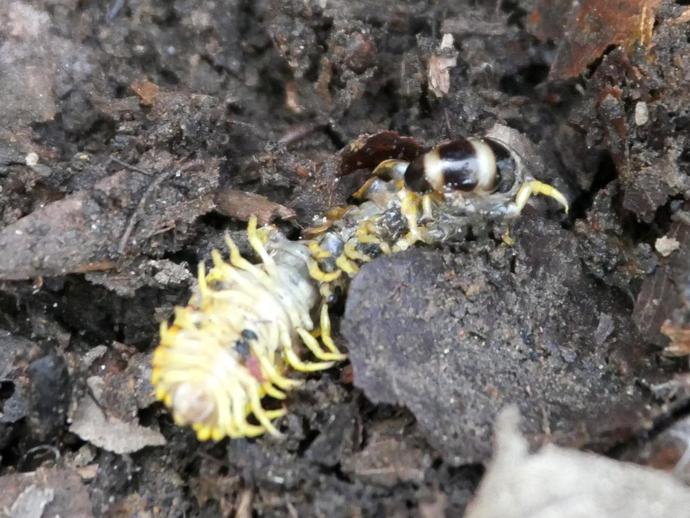April 18, 2020
Today's nature update is something pretty cool (and gross!) that you don't see every day. It's also a two-for-one. Here we see two different insects: the yellow thing is a millipede that is having a sincerely bad day, and the shiny black thing that's where the millipede's head should be is a Phengodes larva. Phengodes is an extremely interesting genus of beetles. They belong to the beetle family Phengogidae, which are known as the "glow-worm beetles." The beetle larvae are bioluminescent, meaning that they glow in the dark! Phengodes larvae and larviform females (the females of this family still resemble larvae even when mature) are predators, and they love to eat millipedes.
So how do they do it? Well, you might want to finish your lunch before you find out. According to VMNH Research Technician and Millipede Expert Extraordinaire Dr. Jackson Means (who also identified this scene for me), once the Phengodes finds a millipede, it bites the membrane between the millipede's head and its first trunk segment -- basically the millipede equivalent of a neck. It then injects a toxin that paralyzes the millipede and stops it from releasing cyanide (you might remember from an earlier update that millipedes can release small amounts of cyanide as a chemical defense; it smells a bit like almonds or cherries). Once the millipede's defenses have been disabled, Phengodes removes the millipede's head and begins crawling through its body, eating as it goes, until it exits through the millipede's ... posterior. Ain't nature something? #BenInNature
About this post: Social distancing can be difficult, but the next few weeks present a great opportunity to become reacquainted with nature. While he is working from home, Administrator of Science Ben Williams is venturing outdoors each day to record a snapshot of the unique sights that can be found in the natural world.
This post brought to you by VMNH Supporters Janet and Richard Ashby.

 Hours & Admissions
Hours & Admissions Directions
Directions

